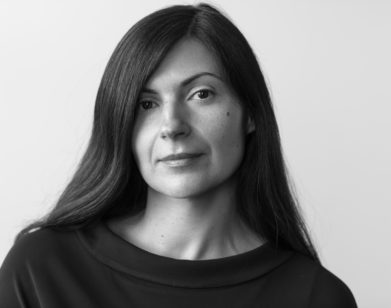5 inspirations
Michelle Hart on the Queer Conundrum That Inspired Her Debut Campus Novel

Michelle Hart. Photo by Candice Singh.
It will surprise no one who has been following Michelle Hart’s profound commitment to LGBTQ literature in recent years, from her perch at the book desk of OprahDaily, to learn that her own debut novel, is a gorgeous and emotionally pitch-perfect achievement. We Do What We Do in the Dark traces the relationship between a young college student, Mallory, and an older, erudite, married professor (this woman goes unnamed in the book). Few titles capture the loaded provocations of their texts so well—of course so much of our brainwork is given over to what we do (or want to do) in the dark; but the title also underscores the ways Mallory grasps and gropes for stability and recognition over the course of a prickly affair. Hart began writing this novel a decade ago during her own college years. Here, the New York writer shares some of her more potent and deliciously queer inspirations with us. —CHRISTOPHER BOLLEN
———

Battlestar Galactica
A reader of We Do What We Do in the Dark would probably never imagine that one of its biggest influences is this early-aughts sci-fi show about a robot rebellion and the apocalypse. I first watched the series—the first of many, many viewings—when I was in high school and college and became almost immediately entranced by Katee Sackhoff’s Starbuck, a suffer-no-fools tomboy fighter pilot. Watching her, I felt that intrinsically queer conundrum: do I want to be this person or be with them? But it wasn’t simply Starbuck being a gay “root” that influenced me. The show jumps forward in time at the end of the second season, propelling us forward one year after some very dramatic stuff goes down. It’s a fascinating storytelling device that asks viewers to fill in the blanks of what we didn’t get to see. I became really enamored with that jumping-ahead technique—something I’d later learn in literary form from writers like Alice Munro, Tessa Hadley, and others. Using this technique, time itself becomes a plot; instead of propelling the audience forward by asking what will happen, the question becomes what has happened and why.
———

Before Sunrise/Before Sunset
Along those same lines, few films have had such an influence on my writing as Richard Linklater’s first two “Before” movies (though Before Midnight, the third in the trilogy, is also excellent). I remember watching Before Sunrise in college and thinking of it as a sort of an elevated romcom—swoony and philosophical, a little bittersweet, just two strangers talking their way into intimacy. And then there’s Before Sunset, which takes place ten years later. What has happened in the intervening decade, and why? Our lovers are now older—are they wiser?—and that large gap of time has caused them to reconsider and recontextualize that youthful dalliance and how it has affected the rest of their lives. After watching it, I knew I wanted to tell a story about a pair of lovers over a long period of time, how that relationship changes or not, how their perceptions of the relationship change or not.
———

It Follows
I’m a big horror movie fan, and It Follows is among the very best I’ve seen. In the seven years since I first saw it, I’ve been chasing the same high; it’s the perfect blend of lizard-brain thrills and artful atmosphere, methodical and shadowy and vividly visceral. I love the way the movie plays with light and darkness (arguably the “scariest” scene happens during the day). Its aesthetics—including its lissome, synth-y score—mesh perfectly with its premise: a sinister supernatural entity is “passed” from person to person via sex, after which it begins to stalk them. It’s an extended metaphor about the cataclysmic consequences of physical intimacy, the way stigma unwittingly lingers. There’s a deceptive simplicity to the film, an almost-minimalism—if it were transposed into text, there’d be a lot of white space. That’s part of what makes it so compelling. It’s unsettling because it leaves a lot of room for the viewer. My book is not at all a work of horror—I hope!—but I admire the movie’s meticulous moodiness.
———

Mac’s “invert colors” feature
Speaking of light and dark, one of the strange things that helped in the writing of this book was discovering Apple’s “invert colors” option, which can turn a black-on-white word doc into one that’s white-on-black. (On my Macbook, it’s command+option+control+8). It’s a bit easier on the eyes, but more thematically, I wrote a lot of the novel’s evening scenes—including the first time the characters have sex—using white text against a black background. It helped me channel the eerie, secretive eroticism of night.
———

Michelle Hart at the Salem Witch Museum. Photo courtesy of Michelle Hart.
Salem, Massachusetts
My experience of Salem was of seeing it in the sun. This was a few years ago. I was about two-thirds of the way through writing my novel and was trying to work out how it ends. I attended a wedding in Salem, on a winter day that was cold but very bright, and was immediately struck by the way this almost mythical town, in wrestling with its infamous past, vacillated between shame and pride. The town treats its history with both a hushed remorse and an almost boastful joy. It felt quintessentially queer. It also felt in keeping with the theme of the book, the interplay between light and dark, truth and obfuscation, innocence and mischievousness. I guess you could say I was bewitched.






